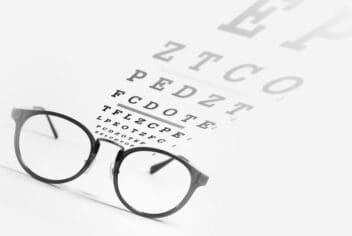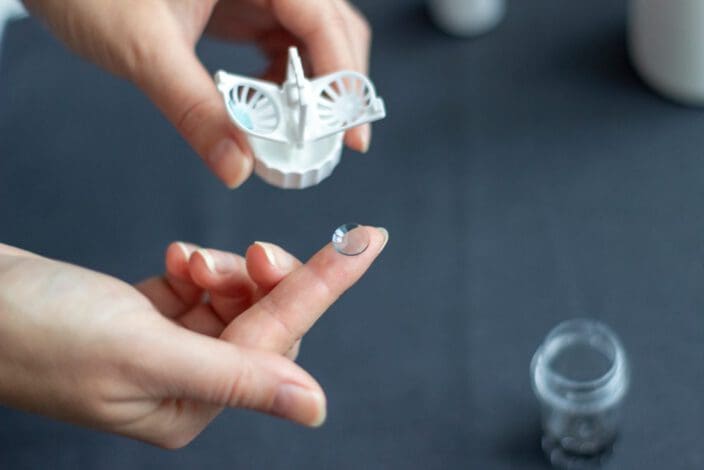Understanding SPH & Other Glasses Prescription Meanings
Home / Everything About Glasses /
Last Updated:
Abbreviations in your eyeglass prescription are based on Latin roots, and it can be challenging to decipher them.

SPH, referring to sphere, is an abbreviation you’ll see on all eyeglass prescriptions. It is listed as a positive or negative number, and it indicates the power of correction you need.
In addition to SPH, there are many more abbreviations you’ll find on your glasses prescription. These abbreviations provide information about each eye, the power of correction you need, the type of vision problem you are dealing with, the measurements of various distances, and other information.
Table of Contents
Contact lens prescriptions have many of the same abbreviations as eyeglass prescriptions, with a few additional numbers. The base curvature and diameter of the lens are indicated on a contact lens prescription, as are the expiration date and brand of lens.
The numbers on your eyeglass or contact lens prescription provide important information about your eye conditions. The presence of certain values — such as cylinder, axis, or add power — informs anyone reading your prescription about the presence of conditions like astigmatism, nearsightedness, and farsightedness, or the need for bifocal or multifocal lenses.
Comprehensive eye exams are the only way to ensure that you are getting the correct glasses prescription and vision correction. Directly following an exam, your ophthalmologist can provide you with a prescription and bring you one step closer to achieving clear vision.
What Is SPH?

Sphere (SPH) on your eyeglass prescription refers to the amount of lens that is needed to bring your vision back to normal. It is measured in diopters and suggests that you need a spherical correction for your sight.
An SPH number indicates if you are farsighted or nearsighted. If the SPH value is 0.00, or noted by Plano, Pl, or an infinity sign, you do not have a vision distance problem. Typical SPH numbers range between 0.00 and +/- 20.00.
You deserve clear vision. We can help.
With 135+ locations and over 2.5 million procedures performed, our board-certified eye surgeons deliver results you can trust.
Your journey to better vision starts here.
The SPH number on a glasses prescription is listed as a positive (+) or negative (-) number. A negative number means that the lens is correcting for nearsightedness, while a positive number indicates a prescription for farsightedness.
The higher the SPH number, the stronger your prescription is, explains the American Academy of Ophthalmology (AAO).
Abbreviations for Glasses Prescriptions
In addition to SPH, many other abbreviations are included in an eyeglass prescription. Fortunately, the abbreviations have been standardized around the world, so you can take your eyeglass prescription to get a replacement set of glasses even when traveling or living abroad.
Here are the most common abbreviations:
- OD: This stands for oculus dexter, indicating the right eye.
- OS: This stands for oculus sinister, indicating the left eye.
- OU: This stands for oculi uterque, indicating both eyes.
- PWR: Short for power, PWR can be a positive or negative number referring to the corrective lens power needed. It is closely related to SPH.
- ADD: Short for addition, ADD refers to the power that needs to be added to the lens to improve near vision.
- CYL: Short for cylinder, CYL indicates a correction for astigmatism. It is usually a number between -4.0 and +4.0.
- AX: An abbreviation for axis, AX is a number between 0 and 180 that indicates the angle between the two meridians of an astigmatism.
- SVD: This stands for single vision distance, which is needed for the correction of distance vision only.
- SVN: This is short for single vision near, which is needed for the correction of near vision only.
- PD: This stands for pupillary distance, which represents the measurement of the distance (in millimeters) between the center of each pupil. It is essential for creating effective and comfortable glasses. Average PD is 62 mm for women and 64 mm for men, with an overall range of 58 to 68 mm.
- BVD: This is short for back vertex distance. BVD is the distance from the back of your glasses lens to the apex of your cornea, and it is adjusted to change the lens power.
You will not find all of the above abbreviations on every eyeglass prescription. Only the abbreviations applicable to your eye condition will be listed.
Numbers are also likely to vary between each eye and can change over time. Keeping your eyeglass prescription up-to-date is essential for maintaining effective corrective eyewear.
Abbreviations for Contact Lens Prescriptions

Contact lens prescriptions provide the same information as eyeglass prescriptions, with the addition of some extra numbers.
The size of the lens, for example, is included for contact lenses. Because contact lenses sit directly on your eye rather than a few centimeters away, the power of a contact lens will also likely be different than an eyeglass prescription for the same person.
Additional information provided on a contact lens prescription includes:
- BC, which is the base curvature of the lens.
- DIA, which is the diameter of the lens.
- An expiration date.
- Different parameters for each eye.
- The brand of contact lens.
The base curve value of a contact lens typically ranges from 8.0 to 10.0. Base curves vary by brand, so your prescription may change depending on what brand of lenses you are using.
Diameter values range between 13 and 15. It is possible to use a different brand of contact lens in each eye based on the unique needs of each eye.
You deserve clear vision. We can help.
With 135+ locations and over 2.5 million procedures performed, our board-certified eye surgeons deliver results you can trust.
Your journey to better vision starts here.
Prescription Numbers for Certain Eye Conditions
Many of the abbreviations in glasses and contact lens prescriptions are associated with numbers. Each number indicates information about your eye, vision, and how much correction is needed to achieve clear vision.
Certain abbreviations and numbers refer to specific eye conditions, such as the following:
- CYL and AX values for toric or astigmatism correction.
- ADD values for “add power” or “extra strength” for bifocal or multifocal lenses.
- SPH values for nearsightedness or farsightedness.
- A prism value is given to people with focusing disorders, such as crossed eyes, and helps to displace images into the proper direction.
The presence of these numbers in your eyeglass prescription provides information about your vision condition and what you need correction for. An eye care professional can identify these values and ensure that you are fitted with proper corrective eyewear.

Getting the Right Glasses Prescription
In order to get an accurate eyeglass prescription, you will need to see an eye care professional who can perform a complete eye exam.
According to AAO, all adults should receive a comprehensive eye exam by the age of 40. At 40, many early warning signs of disease and eye problems start to appear.
You do not need to wait until you are 40 to get your first eye exam. People with a history of diabetes, high blood pressure, and a family history of eye disease are encouraged to see an ophthalmologist for vision screenings sooner. For people already using corrective eyewear, it is wise to get an updated prescription each year.
Once your eye exam is complete, your eye doctor should be able to give you an accurate eyeglass or contact lens prescription right away.
You deserve clear vision. We can help.
With 135+ locations and over 2.5 million procedures performed, our board-certified eye surgeons deliver results you can trust.
Your journey to better vision starts here.
References
- Eye Exam and Vision Testing Basics. (December 2018). American Academy of Ophthalmology.
- What Do Astigmatism Measurements Mean? (August 2018). American Academy of Ophthalmology.
- How to Read Your Contact Lens Prescription or Rx. Davis Vision.
- How to Read and Eyeglass Prescription. (October 2019). Verywell Health.
- How to Read Your Eyeglass Prescription. WebMD.
This content is for informational purposes only. It may have been reviewed by a licensed physician, but is not intended to serve as a substitute for professional medical advice. Always consult your healthcare provider with any health concerns. For more, read our Privacy Policy and Editorial Policy.
